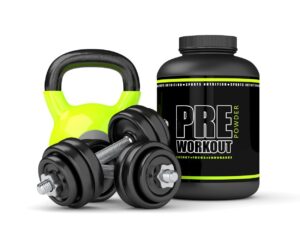
Understanding the different types of resistance training is crucial in designing an effective workout regime. It is essential for everyone, from novices to experienced athletes, to be aware of the multiple techniques accessible for constructing muscle and enhancing body composition.
This blog post will delve into several popular forms of resistance exercise, such as weightlifting, bodyweight exercises, and workouts using resistance bands. Discover the advantages and disadvantages of every technique, in addition to useful advice on how to include them into your regular routine safely.
We’ll also discuss important considerations when progressing in your general resistance-exercise plan. From learning how athletes lift heavy weights typically fewer times for powerlifting or Olympic lifting to understanding how free weights can enhance your bench press performance – we have got you covered.
Table of Contents:
- Weight lifting: Pumping Iron with a Purpose
- Bodyweight Exercises
- Utilizing Resistance Bands in Your Workout Regimen
- Progression and Safety
- FAQs
- Conclusion
Weight lifting: Pumping Iron with a Purpose

When it comes to resistance training exercises, weightlifting takes the crown. This classic exercise is like the king of the gym, using free weights and machines to sculpt those muscles and make you feel like a superhero.
The Ups and Downs of Free Weights
Free weights are like the Swiss Army knives of the gym. They work not only your main muscles but also those sneaky stabilizers, giving you a well-rounded workout. According to the Mayo Clinic, this extra engagement can improve balance, coordination, and strength. Talk about a triple threat.
- Muscle Activation Magic: Free weights require more control, so your muscles have to work harder. It’s like a magic spell for muscle growth.
- Versatility Vibes: With free weights, you can do all sorts of exercises to target different parts of your body. It’s almost like having your own personal fitness guru at the ready.
- Risky Business: But beware, my friend. If you don’t use proper form or go too heavy too soon, you might end up injured. Safety comes first, always.
Weight Machines: The Safety Net for Newbies
Weight machines are used for popular resistance exercises and are like the training wheels of the gym. They guide your movements along a fixed path, making them a safer option for beginners or those recovering from injuries. Ensure you understand how to use the machines correctly before commencing your workout.
- Safety Dance: Machines offer a safety net by supporting your body throughout each movement. It’s like having a spotter without the awkward small talk.
- Target Practice: These machines are all about precision. They let you focus on specific muscle groups, which is great for rehabbing after injuries. Bullseye.
- Functionality Limitation: But here’s the catch. Machines don’t engage those stabilizer muscles as much as weights do, so they might not give you that overall functional fitness. It’s like skipping leg day for your stabilizers.
Bodyweight Exercises

If you can’t hit the gym or prefer home workouts, bodyweight exercises are your go-to. No equipment needed, just your own body serving as resistance. It’s a struggle against gravity but in an advantageous manner. These exercises strengthen multiple muscle groups, boost flexibility, coordination, and balance.
Popular Bodyweight Exercises for Beginners
Ready to dive into bodyweight training? Here are some exercises you can do anywhere:
- Squats: Target those quads, glutes, and hamstrings.
- Push-ups: Give your chest, triceps, and shoulders some love.
- Lunges: Work that lower body with quads, hamstrings, calves, and glutes.
- Burpees: A cardio powerhouse that combines squats, push-ups, and jumps.
No need to worry; I have got you covered. Check out detailed instructions on how to do these exercises correctly and avoid injury.
The Advantages of Incorporating Bodyweight Exercises into Your Routine
Why choose bodyweight training over traditional gym workouts? Let me count the ways:
- No Equipment Needed: Just you and some space to move around.
- Versatility: Modify moves to fit your fitness level, from beginner to advanced.
- Affordability: No need for pricey equipment or gym memberships. It’s practically free.
- Easily Accessible: Whether you’re traveling or stuck at home, you can always squeeze in a quick workout.
For those wanting to take their bodyweight training further, this guide offers the best exercises for men and women alike. And ladies, don’t worry; these moves aren’t gender-specific. They benefit everyone equally.
Remember, consistency is key when it comes to fitness goals. So why not add some of these simple yet effective moves to your daily routine? They’ll improve strength and endurance and contribute to your overall health and wellness goals.
Utilizing Resistance Bands in Your Workout Regimen

If you want a workout that’s as versatile as a chameleon and effective as a ninja, then resistance bands are your new best friend. These stretchy wonders are not only lightweight and portable, but they also come in different tensions to suit all fitness levels. Resistance bands are essential for any workout, regardless of your fitness experience.
Effective Workouts You Can Do With Resistance Bands
Resistance bands are a popular type of resistance training that allows you to move like a breakdancer on the dance floor. Unlike those clunky gym machines, they engage multiple muscle groups at once, giving you a full-body workout. From bicep curls to squats, there’s no limit to the exercises you can do with these bands.
- Bicep Curls: Stand on the band with feet shoulder-width apart, hold the ends with hands down at your sides, and curl those guns towards your shoulders.
- Lateral Raises: Stand over the band with feet together, grip the ends firmly, and raise your arms parallel to the floor like you’re about to take off.
- Squats: Step onto the band, hold the handles by your shoulders, and squat like you’re sitting back into an invisible chair. Stand back up and repeat.
For a comprehensive guide on how to do the exercises correctly, please consult Healthline.
Why Choose Elastic Tubing Over Traditional Gym Equipment?
Resistance bands are like the superheroes of the fitness world. They give you a killer workout without the need for heavy weights or bulky machines. Plus, they’re perfect for on-the-go fitness enthusiasts or those with limited space at home. Talk about convenience.
Unlike traditional gym equipment that only targets one muscle group at a time, resistance bands work multiple muscles simultaneously. It’s like a party for your muscles; they’re all invited. This means more calorie burn and improved coordination, leading to functional strength and flexibility.
Not only are resistance bands cost-effective compared to pricey gym memberships or buying personal equipment, but they also reduce the risk of joint stress. You can adjust the intensity to your comfort level, making workouts safer for beginners, the elderly, and those recovering from injuries. Check out this article from Greatist to learn more about the benefits of incorporating resistance bands into your exercise routine.
Progression and Safety
Get ready to pump some iron and stay injury-free. In strength training, it’s all about gradually increasing the intensity while keeping safety in mind. Don’t rush, or you might end up looking like a tangled mess of resistance bands.
Tips for Gradually Increasing Intensity
Want to level up your gains? Here’s how:
- Start Small: Begin with weights that won’t make you collapse like a deflated balloon after 2 reps.
- Increase Gradually: Slowly add more weight or resistance bands, but don’t go from zero to Hulk mode in a day.
- Maintain Proper Form: No matter how heavy you lift, don’t turn into a human pretzel. Keep that form on point.
The Importance of Safety Measures
Don’t be a daredevil in the gym. Safety first, folks.
- Prioritize Warm-ups & Cool-downs: Warm up those muscles and cool down like a boss to avoid feeling like a rusty robot the next day.
- Lift Safely: Don’t be a lone wolf. Have a spotter around when lifting heavy weights, or you might end up stuck like a turtle on its back.
Remember, whether you’re into weights, bodyweight exercises, or resistance bands, take it easy at first and gradually increase the challenge. Safety is key when it comes to working out.
FAQs
What are the different types of resistance training?
The primary types of resistance training include weightlifting with free weights or machines, bodyweight exercises, and workouts using resistance bands.
What are the 3 types of resistance exercise?
The three main categories of resistance exercise are isotonic (moving a constant load), isometric (holding a static position), and plyometric (quick, explosive movements).
What are the big 5 resistance training?
The “big five” in resistance training refers to squats, deadlifts, bench press, overhead press, and bent-over rows. These exercises target multiple muscle groups.
What is the most common type of resistance training?
Weight lifting, including both free weights and machine-based lifting, is typically considered the most common form of resistance exercise.
Conclusion
In conclusion, understanding the different types of resistance training modalities can help you tailor your workouts to meet your specific goals.
Weightlifting with free weights or machines offers unique benefits and drawbacks, while bodyweight exercises provide beginners with a convenient and effective option.
Incorporating resistance bands into your routine can add variety and challenge, and it’s important to increase intensity while prioritizing safety measures to prevent injury gradually.
By exploring these various forms of strength training, you can find what works best for you in achieving optimal results.



